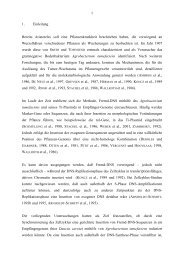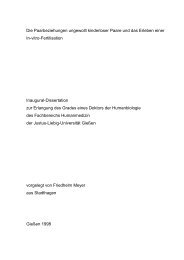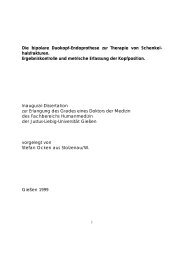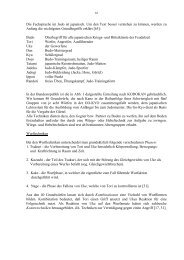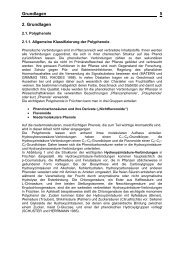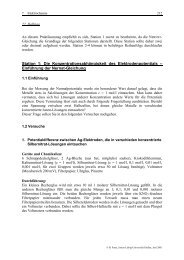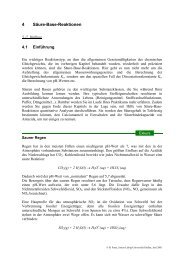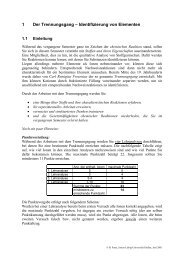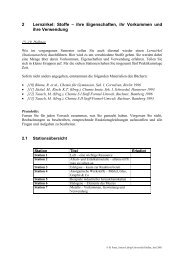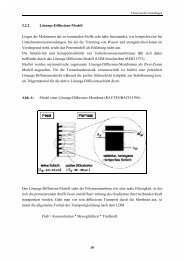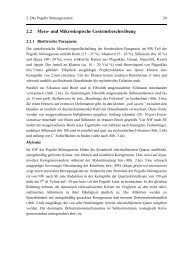Effects of diabaticity on fusion of heavy nuclei in the dinuclear model ...
Effects of diabaticity on fusion of heavy nuclei in the dinuclear model ...
Effects of diabaticity on fusion of heavy nuclei in the dinuclear model ...
You also want an ePaper? Increase the reach of your titles
YUMPU automatically turns print PDFs into web optimized ePapers that Google loves.
λ dur<strong>in</strong>g <strong>the</strong> lifetime t 0 <str<strong>on</strong>g>of</str<strong>on</strong>g> <strong>the</strong> d<strong>in</strong>uclear system. The competiti<strong>on</strong> between two possible fusi<strong>on</strong><br />
channels was studied. The λ—channel describes <strong>the</strong> transiti<strong>on</strong> <str<strong>on</strong>g>of</str<strong>on</strong>g> two <strong>nuclei</strong> <strong>in</strong>to <strong>the</strong> compound<br />
nucleus with <strong>the</strong> el<strong>on</strong>gati<strong>on</strong> coord<strong>in</strong>ate λ for a fixed mass asymmetry η dur<strong>in</strong>g <strong>the</strong> fusi<strong>on</strong>.<br />
The sec<strong>on</strong>d channel, named η—channel, describes <strong>the</strong> evoluti<strong>on</strong> <str<strong>on</strong>g>of</str<strong>on</strong>g> <strong>the</strong> d<strong>in</strong>uclear system to <strong>the</strong><br />
compound nucleus as a change <str<strong>on</strong>g>of</str<strong>on</strong>g> <strong>the</strong> mass asymmetry η by nucle<strong>on</strong> transfer from <strong>the</strong> light<br />
nucleus to <strong>the</strong> <strong>heavy</strong> <strong>on</strong>e.<br />
The quasi-fissi<strong>on</strong> process <str<strong>on</strong>g>of</str<strong>on</strong>g> <strong>the</strong> d<strong>in</strong>uclear system was studied solv<strong>in</strong>g a transport master-<br />
equati<strong>on</strong> for <strong>the</strong> exchange <str<strong>on</strong>g>of</str<strong>on</strong>g> nucle<strong>on</strong>s between <strong>the</strong> parts <str<strong>on</strong>g>of</str<strong>on</strong>g> <strong>the</strong> d<strong>in</strong>uclear system, which also<br />
takes <strong>the</strong> decay <str<strong>on</strong>g>of</str<strong>on</strong>g> <strong>the</strong> d<strong>in</strong>uclear system <strong>in</strong> <strong>the</strong> el<strong>on</strong>gati<strong>on</strong> λ <strong>in</strong>to account.<br />
In this work, we have obta<strong>in</strong>ed <strong>the</strong> follow<strong>in</strong>g results:<br />
• The diabatic effects <strong>in</strong> <strong>the</strong> entrance phase <str<strong>on</strong>g>of</str<strong>on</strong>g> <strong>the</strong> reacti<strong>on</strong> give rise to h<strong>in</strong>drances for <strong>the</strong><br />
growth <str<strong>on</strong>g>of</str<strong>on</strong>g> <strong>the</strong> neck and for <strong>the</strong> moti<strong>on</strong> to smaller relative distances.<br />
• The diabatic potentials as a functi<strong>on</strong> <str<strong>on</strong>g>of</str<strong>on</strong>g> <strong>the</strong> el<strong>on</strong>gati<strong>on</strong> λ are similar to <strong>the</strong> phenomeno-<br />
logical double fold<strong>in</strong>g potentials used <strong>in</strong> <strong>the</strong> d<strong>in</strong>uclear system <strong>model</strong> <str<strong>on</strong>g>of</str<strong>on</strong>g> fusi<strong>on</strong>.<br />
• For <strong>the</strong> asymmetric d<strong>in</strong>uclear system, <strong>the</strong> diabatic h<strong>in</strong>drance for <strong>the</strong> moti<strong>on</strong> to smaller<br />
el<strong>on</strong>gati<strong>on</strong>s λ is smaller than for <strong>the</strong> symmetric d<strong>in</strong>uclear system. Therefore, its evoluti<strong>on</strong> to<br />
<strong>the</strong> compound nucleus <strong>in</strong> λ is more favored.<br />
• The potentials as a functi<strong>on</strong> <str<strong>on</strong>g>of</str<strong>on</strong>g> <strong>the</strong> mass asymmetry η at <strong>the</strong> touch<strong>in</strong>g c<strong>on</strong>figurati<strong>on</strong> <str<strong>on</strong>g>of</str<strong>on</strong>g><br />
<strong>the</strong> <strong>nuclei</strong> calculated with<strong>in</strong> <strong>the</strong> TCSM are similar to <strong>the</strong> <strong>on</strong>es calculated us<strong>in</strong>g o<strong>the</strong>r methods.<br />
• The isotopic dependence <str<strong>on</strong>g>of</str<strong>on</strong>g> <strong>the</strong> fusi<strong>on</strong> barrier <strong>in</strong> η, calculated with<strong>in</strong> <strong>the</strong> TCSM, agrees<br />
with <strong>the</strong> isotopic behaviour <str<strong>on</strong>g>of</str<strong>on</strong>g> <strong>the</strong> experimental surplus <str<strong>on</strong>g>of</str<strong>on</strong>g> energy ∆B exp = B exp − BBass above<br />
<strong>the</strong> Bass barrier BBass.The value <str<strong>on</strong>g>of</str<strong>on</strong>g> B exp is def<strong>in</strong>ed as <strong>the</strong> value <str<strong>on</strong>g>of</str<strong>on</strong>g> <strong>the</strong> bombard<strong>in</strong>g energy for<br />
a fusi<strong>on</strong> probability 0.5.<br />
• The adiabatic and diabatic microscopical mass parameters for <strong>the</strong> neck degree <str<strong>on</strong>g>of</str<strong>on</strong>g> freedom<br />
ε are much larger than <strong>the</strong> <strong>on</strong>e obta<strong>in</strong>ed <strong>in</strong> <strong>the</strong> hydrodynamical <strong>model</strong> with <strong>the</strong> Werner-Wheeler<br />
approximati<strong>on</strong>. By apply<strong>in</strong>g <strong>the</strong> microscopical mass parameters, we f<strong>in</strong>d a relatively stable neck<br />
dur<strong>in</strong>g <strong>the</strong> time <str<strong>on</strong>g>of</str<strong>on</strong>g> reacti<strong>on</strong>.<br />
• The d<strong>in</strong>uclear system is stable aga<strong>in</strong>st a melt<strong>in</strong>g <strong>in</strong> λ and ε. The diabatic effects and <strong>the</strong><br />
microscopic mass parameters give a justificati<strong>on</strong> for <strong>the</strong> use <str<strong>on</strong>g>of</str<strong>on</strong>g> <strong>the</strong> d<strong>in</strong>uclear system <strong>in</strong> <strong>heavy</strong><br />
i<strong>on</strong> collisi<strong>on</strong>s at low energies.<br />
107



